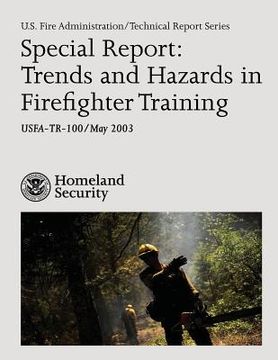Reseña del libro "Special Report: Trends and Hazards in Firefighter Training (en Inglés)"
The range of services provided by America's fire service continues to expand. In many areas, the local fire department is responsible for mitigating hazardous materials incidents, performing technical rescues, and providing emergency medical services. The threat of terrorist incidents further increases the fire department's responsibility, as firefighters must be taught to recognize the signs of a chemical or biological attack and the proper response. This expansion of the fire service's responsibilities means that less time and energy are available to focus on basic fire suppression skills and scenarios. Also, some of the newer missions present their own, inherent training dangers. In addition, the personal protective gear being worn by firefighters today is excellent; some say that it is even too protective. Firefighters now can advance deeper into structures and get closer to the seat of a fire than in years past because the turnout gear protects well against heat, but this can create problems. A longer exposure to fire will rapidly deplete a firefighter's energy and air supply; and the firefighter will have a greater distance to travel to an exit in an emergency situation. Furthermore, as firefighters progress farther into a structure, more time elapses, which means the fire is more devel¬oped, hotter, and often closer to flashover. Due to the increased use of synthetic and polycarbonate construction materials, fires are burning hotter and faster than in the past, resulting in a higher potential for building collapse and flashover. Collapse becomes more likely because of the increased damage from the fire. Safe, effective, and realistic firefighter training is essential in preparing the fire service to achieve its mission of preserving life and property. The dilemma posed by conducting realistic fire training is that fires, even in a training setting, are inherently dangerous. Yet, the fire service needs realistic scenarios to fully experience the environment of a fire and how to combat it. Even without the presence of live fire, training on the physically challenging and labor-intensive tasks of hose handling, tool work, and ladder operations pose a high potential for injuries. From 1987-2001 there has been a 31 percent decrease in the incidence of structure fires throughout the United States. As a result of the decline in fires, firefighters on the whole have less fireground experience than their predecessors had a generation ago. As many of the more experienced firefighters and officers retire, they are replaced by young officers with comparably less fire experience. As today's firefighters' collective, direct experience in fighting fires continues to diminish, there is great concern in the fire service that the inability to recognize flashover and building collapse-and to react quickly enough to avoid being caught by these two potentially fatal conditions-will continue to result in injuries and fatalities to firefighters. Complicating this situation is that live fire training with Class A combustible materials (especially in acquired structures) is being replaced by temperature-controlled, fuel-fed fires in non-combustible structures. Departments are relying less on live fire training for myriad reasons, including among others, environmental, safety, and cost. This report examines recent injurious and fatal incidents involving training to determine lessons that can be used to prevent future injuries and deaths. The emphasis in this report is on fire-related training, particularly live-fire evolutions. It is, however, important to note that training-related injuries can and do occur during a variety of types of training. Also included is a discussion of training standards and common hazards as well as a brief analysis of the available data on the number and cause of training-related injuries and deaths.

